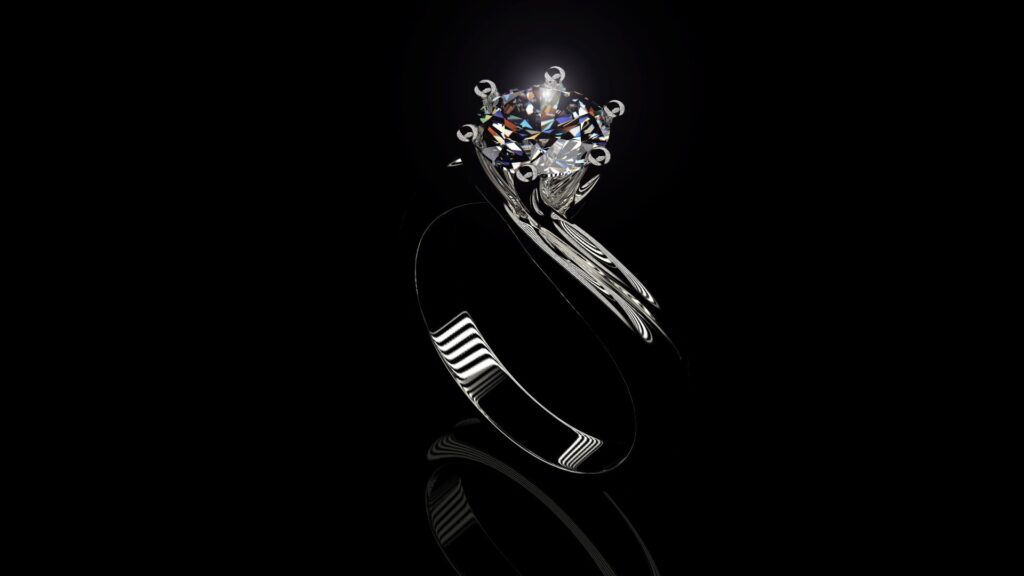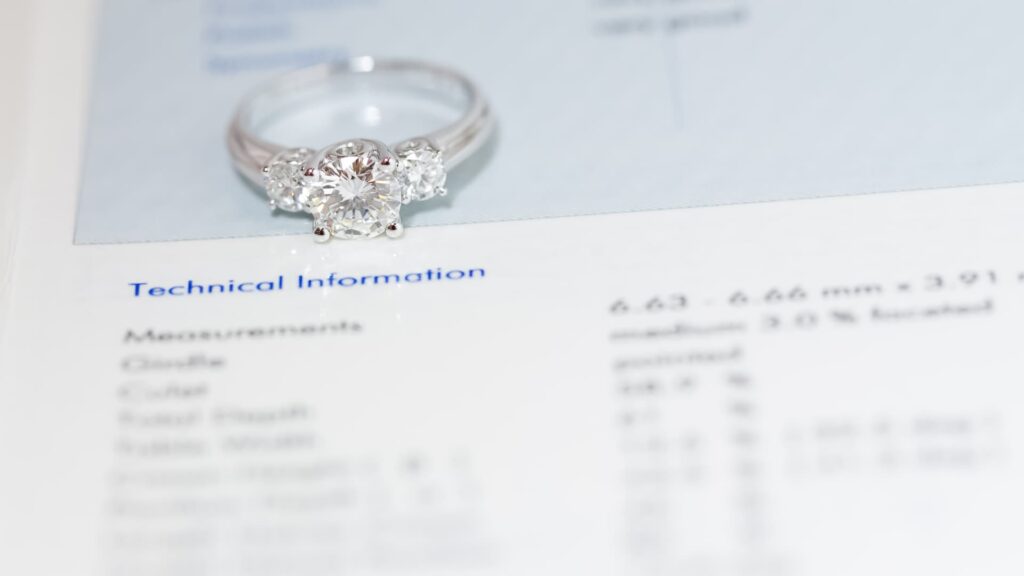Diamond color refers to the amount of yellowish tint or hue present in the diamond. An ideal diamond would be perfectly transparent with no hue. However, that sight is quite rare. High-quality diamonds are quite close to that, but as the quality of a diamond gets lower, it exhibits a prominent yellow/brownish hue.
Most diamond colors on the scale are hardly distinguishable, which suggests that there’s no reason to overpay for certain diamond colors. Diamonds are graded by keeping the GIA color scale as a standard.
The highest grade on a GIA color scale is D from the ‘colorless’ category, and the last grade on the scale is Z which shows a visible yellow tint, even with an unaided eye. Here’s how the scale looks:

The color grades under comparison here, J and K, belong to the ‘near colorless’ and ‘faint yellow’ categories, respectively. Despite that, the difference between these two is quite negligible.
So let’s find out what these color grades represent in a diamond!
What is a J Color Diamond?
A J color diamond belongs to the near-colorless category on the GIA color grade scale. It sits at the last position in this category and is only one position ahead of the faint-colored category.
Despite that, a J color diamond can be a great choice in most situations because, after all, it looks near colorless to the naked eye. Here’s how a J color diamond from James Allen looks:
In contrast to that, here’s a G color diamond that stands first in the ‘near colorless’ category:
The difference is somewhat noticeable in these images. But to an untrained, unaided eye, this difference will not be as obvious as long as the diamond is in the right cut.
J color diamonds show a slight yellowish tint or hue that becomes more prominent in certain cuts or settings. So what does that mean?
A J color diamond gives you limited choices when it comes to settings or cuts. For instance, the hues in a J color diamond become more obvious in an emerald or Asscher cut. As for the setting, a platinum or white gold setting can make a J diamond look absolutely underwhelming.
This is because the yellow or rose gold settings are great at masking the yellowish hue in the diamond. On the other hand, white gold settings will elevate the appearance of the yellow tinge in the diamond by creating a contrast.
In essence, a J-color diamond can be an amazing option as long as you get your hands on the right diamond, i.e., the cut, setting, or shape of the diamond should complement its color.
What is a K Color Diamond?
A K-color diamond is from the ‘faint’ category of the GIA color scale. It stands first in its category and is only one grade below the J color.
A diamond with a K grade indicates that it will show a faint yellow tint that is almost always noticeable by the naked eye. You can see that in the image of a diamond from the Blue Nile below:
This hue shouldn’t be a big deal for most of you because it really does not look awful. In fact, there are several color grades that come after K, whereas it is just one step below the ‘near colorless category.
This suggests that the slight tinge in a K diamond can be tamed the same way as a J diamond. You just need to have your K-graded diamond in the proper cut and setting.
By that, I mean you should choose cuts that are great at reflecting light and masking the flaws of a diamond, primarily a brilliant round cut. And avoid choosing cuts that make your diamond look terrible, like an emerald or pear-shaped cut.
Also, for diamonds that show a yellowish tinge, yellow gold settings work well to neutralize the appearance of the diamond and make a great compliment.
So I’d really not stop you from choosing a K-color diamond because it can look incredibly great while saving you lots of money as well!
What is the difference between J and K Color Diamond?
The difference between a J and K color grade of a diamond is very little. However, these differences can greatly vary depending on the diamond’s cut grade, fluorescence or brilliance, etc.
Since every diamond shows different behavior, we cannot say for sure how much of a difference you’ll notice. But here are a few characteristics that set the J and K color grades apart from each other.
Different Categories on the Color Scale
The primary and most obvious difference between a J and K color diamond is the fact that they belong to different categories on the color scale.
J belongs to the ‘near colorless’ category while K is from the ‘Faint’ colored category. This very factor makes people assume that diamonds with these respective color grades will be quite different from each other.
K is often thought of as a color that shows a prominent yellow tint, and J, being from the near-colorless category, gets privileged due to its name. However, in reality, the difference is quite minor.
Both J and K color diamonds show an almost similar yellowish hue, for both of them sit adjacent to each other on the GIA scale.
K Color Diamonds show a Warmer Tint.
Since the K grade on the GIA color scale belongs to the ‘faint’ color category, you can expect the same from these diamonds, i.e., a faint yellow color.
A K-color diamond shows a distinct yellowish tinge on its surface which is easily noticeable by the naked eye as well.
If you examine a K diamond from a face-up view, you may not notice an awful yellow hue. Like this diamond from James Allen:
However, a side profile examination of the same diamond shows quite more color, like so:
But that really shouldn’t be a matter of concern because your diamond will most probably take the shape of jewelry. It will go in a certain type of setting, which will hide its side profile, leaving only the face-up view a matter of concern.
J Color Diamonds are Near Colorless
With standing last in the near-colorless category, a J color diamond shows a very slight yellow tinge. This yellowish hue is not as noticeable, especially if the diamond is in the right cut.
A J color diamond primarily looks close to colorless to an unaided eye, especially when viewed in isolation. But in comparison, you will be easily able to discern between a J-colored diamond and a D (colorless) diamond.
Nevertheless, a J color diamond in the right cut can look incredibly stunning and save you a lot of money too. And you know what can be a wise decision? Saving your money and spending it on getting a better caratage and cut grade of the diamond!
Near Colorless Diamonds fetch a Higher Value.
Owing to their standing on the GIA color scale, near colorless diamonds (G to J) fetch a higher value than faint yellow (K to M) diamonds.
This is mainly because near-colorless diamonds are considered more beautiful and hence, more desirable. That, in turn, increases their worth as well as the price tag.
On the contrary, faint yellow diamonds are often not the first choice of consumers because of their faint visible tint. And so they are priced lower than the nearly colorless diamonds.
Price Comparison: J vs. K Color Diamond
J and K color grades of a diamond sit adjacent to each, which suggests that the price difference between them will not be massive. In some cases, the price difference between a J and K diamond is quite negligible, while in others, you may see a $2-6k jump.
Anyway, I’ll let you assess the price difference on your own by sharing a few diamonds from James Allen and the Blue Nile. So let’s see how that goes!
Let’s start by considering a diamond from James Allen. The following features will be the variables:
· Carat: 2.00
· Cut: Ideal
· Clarity: VVS2
· Shape: Round Brilliant
A J-colored diamond with the aforementioned features fetches a price as high as $22,200 at James Allen.
In contrast, a K-colored diamond with all else the same will cost you around $18,650. However, these diamonds are the highest-priced diamonds in their respective categories.
There are instances where the price difference is close to none like these two ct. J Color diamond is available at $14,910, whereas a two ct. K Color diamond is priced at $14,570.
Likewise, at the Blue Nile, I didn’t find the difference between the prices of J and K color diamonds to be massive. But the average price gap was around $2-3k.
This 2.01 ct. A round diamond with VVS2 clarity, Ideal Cut, and a J color grade is priced at $17,667, while a similar diamond with a K color grade will cost you $2k less at $15,773.
In short, every diamond fetches a different value which is why we cannot limit the price difference to a certain number. However, one thing that stays constant is the higher value of a J color diamond.
J vs. K Color Diamond: Which is better?
So here’s the real question. Which one should you choose between a J and K-graded diamond? Well, that’s going to be a hard choice.
Both J and K colored diamonds show a noticeably yellowish tint. The difference between their color is very slight, and unfortunately, both of them do reveal their color to an unaided eye as well.
Both J and K color diamonds can prove to be great choices for jewelry, provided that they’re in a cut as well as set in a yellow or rose gold setting, which typically balances the diamond color.
But the majority of the time, the color of a K diamond is stronger than a J diamond and hence, more easily visible to the naked eye. On the other hand, a J color diamond can look as stunning as a G-colored diamond at times.
So if you’re gonna spend, you might as well save some extra $500-2000 and invest it in a better color grade. A J color diamond will almost always prove to be the better choice. However, a side-by-side comparison can help you make the right choice.
If you’re getting a better value but the same appearance in a K-grade diamond, then go for it and forget about what’s written on the paper!
Final Verdict
Since the J and K grades of a diamond are only one step apart from each other, the differences between the two are negligible quite often. So at the end of the day, you’ll have to assess the choices on your own. But if you’re someone who doesn’t mind warm-toned diamonds, then a K grade would be a perfect choice!
Related Posts:
VS1 vs. VVS2 Diamond Compared






